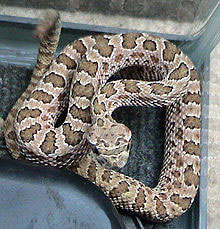
There are many snakes in the badlands area, but the prairie rattlesnake is one hikers should watch for.
Recently, STARS took a nine-year-old girl to a hospital in Calgary after being bitten by a rattlesnake in Dinosaur Provincial Park near Brooks, which is approximately 200 kilometres from Drumheller.
Jeff Zimmer, District Fish and Wildlife Officer for Drumheller said, in his experience, it is rare that someone gets bit.
“Typically when someone does get bit, it is by a bull snake, and it is because they are trying to pick them up,” he said.
He explained that with rattlesnakes, as long as people are aware of the snakes and they avoid them or they see them before they get too close to them, there should not be a problem, but with children it is a different story if they are uneducated about snakes he said.
“The (prairie rattlesnake) is the only species of venomous snakes in Alberta. The toxin levels are very low, because they are on the northern end of their range… the toxicity is quite minimal,” he said.
He told inSide Drumheller that if a healthy person was to be bit by a venomous snake, and if they were to be injected with the venom, it would be similar to a wasp sting.
“In most cases you will be in the hospital and they will monitor you. If your symptoms get worse then they would treat you with the anti-venom,” Zimmer explained.
He continued by saying that the anti-venom is “quite expensive.”
Being relatively new to the area, Zimmer said he has not heard much about rattlesnakes in Drumheller but mentioned that there are bull snakes, especially near the Atlas Coal Mine area.
“If we had rattlesnakes in Drumheller it would be very rare and would be the extreme end of where we would find them,” he said.
The prairie rattlesnake can usually be found in southwestern Saskatchewan and southeastern Alberta as well as in the US in Idaho and Montana, western Iowa all the way to northern Mexico.
Zimmer explained that if a person was to be bit by a rattlesnake it is “in pure defense, it is not that they are trying to eat you, it is that they are doing it to defend themselves. In a lot of cases what will happen is the (snake) will throw its head and will hit you in the leg with their head to ward you off. If they do bite you, they will (either) release the venom before they bite you, or they will release it after.”
He said because of this, in a lot of cases people will end up with what is called a ‘dry bite’, which means the person won’t end up with the venom injected in their system, which is why the hospital will monitor people who come in with a snake bite.
“It is very important that people know what kind of snake it was that bit them, because bull snakes are biters as well,” he said, explaining that bull snakes have no venom because they are constrictors.
He explained that snakes don’t have ears and feel the vibration of vehicles driving by or people walking and that is what alerts them to danger. He continued by noting that if the snake wasn’t to feel a person approach through the vibration, they could be startled which might result in the snake throwing its head at the person to warn them it is there. He also said a rattlesnake will begin to rattle right away.
Zimmer mentioned that if a person was to be bit by a snake typically the procedure is standard first aid for the bite, to treat for shock, and then to get the person to a hospital within three hours, but explained that if a person has underlined health conditions, such as an allergy to a wasp sting, the procedure would change to needing immediate medical attention at a hospital.
“There is a misconception that because (the prairie rattlesnake) is venomous, that it is deadly. But in actuality, they are not because they are on the northern end of their range,” he said.




























